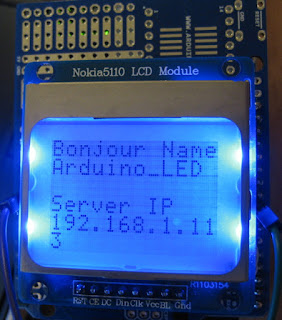Web control an addressable LED strip using ArduinoEthernet

Edited 12/18/2011: Added Perl script and made displayColors(); call fix in event handler. Edited 12/19/2011: Added bulk update POST behavior and updated Perl script to demonstrate. Edited 12/26/2011: Fixed quoting javascript quoting problem. Edited 1/3/2012: Added support for Nokia 5110 style LCD and display bonjour name and IP. Most of my build and status "blinken light" type projects are USB or Bluetooth (Serial) controlled requiring a direct connection to the machine feeding the project it's values. I wanted more standlone device that could be remotely updated. Microcenter has the ArduinoEthernet and Netduino Plus boards, both of which have onboard ethernet. I still can't get my head around the .Net MF framework and which libraries apply to the Netduino vs some other .Net board. The RaspberryPi is probably the biggest newcomer in this space because of its aggressive pricepoint, large feature set and broader set of developer tools. The Arduinos are primitiv...




